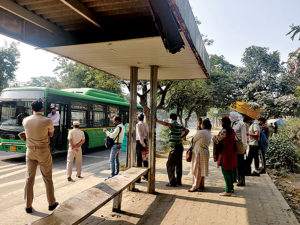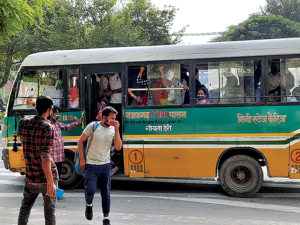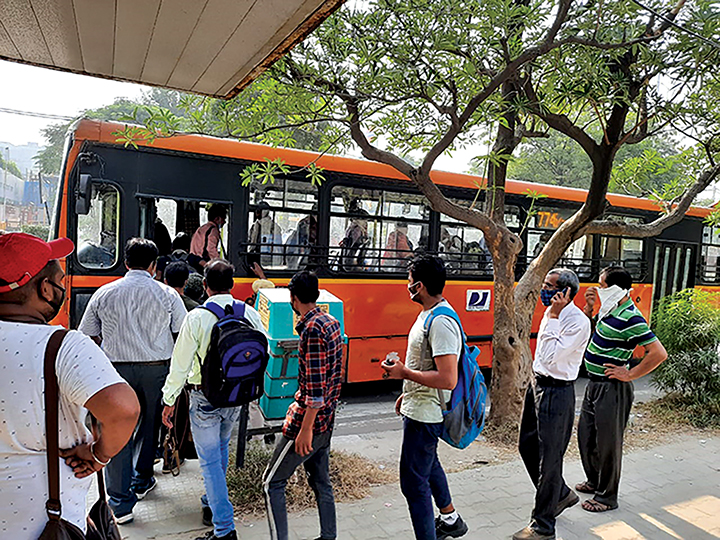Mini-buses running full capacity, hours of wait for a bus, office-goers in the Capital find themselves struggling to reach their workplace with the ever-present fear of contagion during the pandemic
Meenakshi waits for a bus around 9:30 in the morning, hoping one would stop soon and take her to Uttam Nagar, where she works as a beautician. She may have to wait for quite some time, but at least there’s the bright daylight of the Delhi morning, and many people around. The previous night, after her work got over as usual, she reached her bus stop at 8:30pm, waiting for two hours, when she finally gave up hope of any bus stopping to take her home to Dwarka.
Thankfully, she tells us with a look of relief briefly visible over her mask-covered face – as she looks to the corner and spots an RTV going the same way as she needs to – her sister lives around her workplace and came to her rescue on a scooter.
Waiting for long hours for a bus has become the norm for people in Delhi even as the Covid-19 lockdown has been lifted that comes with the enforcement of social distancing norms, allowing just 50% of the capacity on a bus at any given time. For women it’s not just a hassle but a risk, in the metropolitan city with the most crimes against women.
And public transport only ups the risk, which here is of contracting the deadly virus. RTVs which Meenakshi eventually got into, and we saw countless others take, are filling up seats with no social distancing in place.
The bus marshals deployed by the Delhi government for the safety and security of women now also ensure that queues are maintained at bus stops and only the designated number enter the bus – but hold no power over the RTVs. Manoj Kumar, one of the those deployed at the bus stop says that if police personnel were around, the errant buses would comply, but as they (the bus marshals) are not seen as yielding any real power, they are taken for granted and buses packed with people continue to ply.

There are over 6,500 public transport buses in Delhi, including those operated under the DTC and the cluster buses by the Delhi Integrated Multimodal Transit System (DIMTS). In 2017, there were around 800 RTVs and mini-buses allowed to run by the department under stage carriage permits.
There are also plans to bring in 9,000 more within a year as announced by Chief Minister Arvind Kejriwal in March this year while flagging off 100 new low-floor AC buses. The Centre for Science and Environment says the city needs an additional fleet of 13,243 to the existing capacity. Or the efficiency of the buses needs to be increased. “Only if protected bus lanes are introduced immediately, the same fleet can provide more kilometres of service and reduce the additional requirement,” it adds.
According to a report by INAE Forum on Civil Infrastructure on Urban Transportation, the Capital city sees a daily traffic volume of 82,000-4,29,000 vehicles, with the bulk of it being composed of cars at 39.7% of the ratio, followed by two-wheelers with 30.7%, and then come in the buses at a measly 2.7%, a ratio which is not great for a city which battles pollution every year, and of course an incessant traffic nuisance.
Those with the means to access Twitter have complained on the social networking site, tagging the Delhi government’s AAP party, the CM Kejriwal, DTC and transport minister in the Union territory Kailash Gehlot about the lack of buses.
Arvind Kumar, who works at South Ex, says he has to first get a bus to Haus Khas from where he then gets on to a second bus to his workplace. A journey of 60-90 minutes, depending on the traffic, has now become extended to three hours some days, as he waits for a bus to stop.

Chanchal Bhandhari, another man waiting for a bus to take him to work in Nehru Place, says this daily delay has seen his salary get cut during a pandemic which has already been very difficult on people’s livelihood. “It takes me hours to get to work. By the time I reach it’s 12 pm and they take it as half day. It has become so difficult on us. Yesterday I didn’t get any transport so you won’t believe what I did. From here (Dwarka) I went to Devli Khanpur, and from there to Nehru Place. This government has imposed these Covid-19 protocols but has not increased the number of buses. Why wouldn’t it think about how it is affecting us? Neither the conductor nor the bus driver cares. Not even the guard they have kept inside the buses, they run with full capacity, no matter which bus it is. No one cares.”
An elderly man Ram Chander says he has also seen buses which are free drive off without stopping. “I started my travel at 8:30 am from Shyam Vihar and I am making my way to Munirka. Either they should just allow people to sit on all the seats, or increase the number of buses or their frequency”.
While we spoke, the queue of people waiting in line for a DTC bus lengthened. A bus finally arrived and everyone waiting got on. Commuters at the next stop will have to wait for another bus to their destination, which could take 15 minutes, half an hour or even more.





